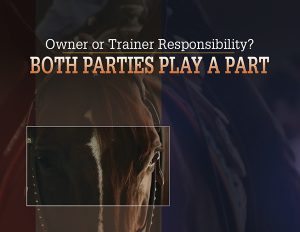Owner or Trainer Responsibility? Both Parties Play a Part
Click here to read the complete article
 By Delores Kuhlwein
By Delores Kuhlwein
In this industry, horse owners and professionals repeatedly enter into mutual agreements with the goal of progressing the career of a horse. What happens if things don’t go as planned, go sideways, or just plain aren’t working out? In modern society, it has become the norm to point fingers and blame a scapegoat when a situation isn’t perfect. Confusion about communication, expectations, and everyone’s role in the situation can wreak havoc.
In the horse world, it’s no different, but the bottom line is that, as a horse owner, it’s your responsibility to stay as informed as possible about your horse and its care. Ultimately, the use of good practices may help you avoid unpleasant situations in the long run.
Role and Responsibility
Horse owner and breeder Beth Mallett of Sierra Vista, Arizona, says owners need to empower themselves by taking responsibility for their own horses, even if they’re under the care of a trainer. “It’s my personal opinion that, as an owner, it’s our responsibility to learn as much as we can about horses in general, such as their expected health care needs for the event they’re in training for. We need to be realistic about a horse’s progress and be flexible with our goals,” she explains. “Hopefully, when we’re armed with these tools, we can be ‘good’ owners for our horses and their trainers.”
Amateur exhibitor Meredith Landy, owner of French Valley Farms in Winchester, California, says that as a breeder who raises horses to show, as well as a competitor who buys prospects, managing the career path of each horse is her most important obligation. “Every horse has a different career path, and in order to determine that, I have to be smart about the programs they go into and to make sure the horse fits the program,” she reveals.
“It takes a lot of evaluation, and some of the decisions aren’t obvious. I have to pay attention and be flexible enough to do what’s best for each animal to have a career path the buyer can see and understand. That’s true for anyone raising young horses, and I spend more time on that aspect than a lot of other functions.”
What that means, explains Missy Thyfault, trainer at Thyfault Performance Horses in Shelby, Ohio, is that owners must choose programs they have studied that will work for their particular horses. “Some programs are more futurity-based, and some are more all-around-based,” she says. “It depends on what your horse is physically and emotionally talented enough to do. Every horse’s needs are different, and the goals have to match up with that horse’s ability.”
It’s understandable that a prospective client might want to vet a training program by chatting with current and past clients. But Stacy Lane Huls of Huls Performance Champions in Temecula, California, says personal research of a program beforehand is key.
“Evaluate the programs and ask questions of previous clients, with the understanding that you should read between the lines depending upon the nature of relationship,” she says. “Both parties play a responsible part, but you need to know what kind of program you’re sending your horse to. Sitting down to interview the trainer beforehand is the owner’s obligation.”
When to Visit










